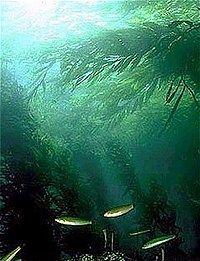Kelp forest

Imagine a big underwater forest full of tall trees, but instead of leaves, they have long, flowing branches covered in greenish-brown seaweed called kelp. This special forest is called a kelp forest, and it can be found in the cold, nutrient-rich coastal waters all around the world.
Just like a forest on land, a kelp forest is also a home for many animals. These include tiny plankton, crabs, snails, sea urchins, fish, sea otters, and even whales. Each of these animals has a special place in the kelp forest ecosystem, helping to balance it and ensure that everything stays healthy.
The kelp forest is created by the kelp plants, which grow upward toward the surface of the water, where they can get sunlight for photosynthesis, just like plants on land. Sometimes, they can grow as much as two feet a day, making them the fastest-growing marine plants in the world.
Kelp forests are important because they provide food, shelter, and a breeding ground for many sea animals. They also play a crucial role in removing carbon dioxide from the Earth's atmosphere, helping to mitigate global climate change.
Sadly, kelp forests are under threat from many environmental factors, including pollution, overfishing, and climate change. As a result, scientists are working hard to protect these precious ecosystems and the animals that call them home.
Just like a forest on land, a kelp forest is also a home for many animals. These include tiny plankton, crabs, snails, sea urchins, fish, sea otters, and even whales. Each of these animals has a special place in the kelp forest ecosystem, helping to balance it and ensure that everything stays healthy.
The kelp forest is created by the kelp plants, which grow upward toward the surface of the water, where they can get sunlight for photosynthesis, just like plants on land. Sometimes, they can grow as much as two feet a day, making them the fastest-growing marine plants in the world.
Kelp forests are important because they provide food, shelter, and a breeding ground for many sea animals. They also play a crucial role in removing carbon dioxide from the Earth's atmosphere, helping to mitigate global climate change.
Sadly, kelp forests are under threat from many environmental factors, including pollution, overfishing, and climate change. As a result, scientists are working hard to protect these precious ecosystems and the animals that call them home.
Related topics others have asked about:
